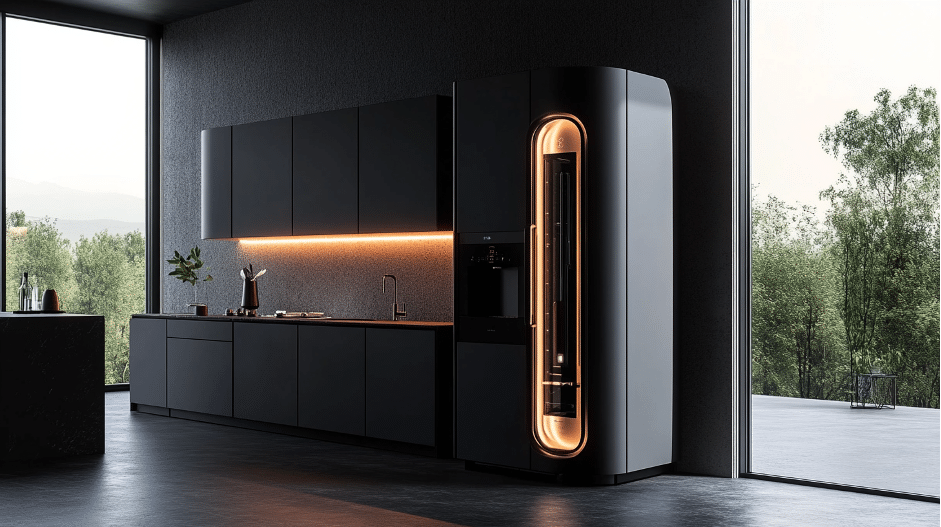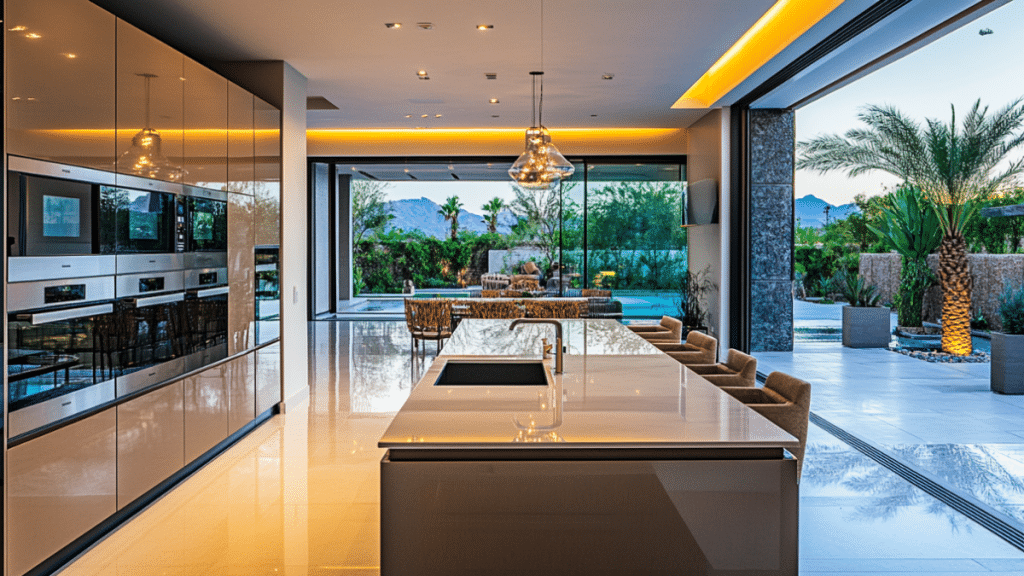In today’s rapidly evolving technological landscape, staying informed about home appliance trends isn’t just about keeping up with the latest gadgets – it’s about making smart, future-proof investments for your home. The home appliance industry is experiencing unprecedented innovation, driven by consumer demands for smarter, more efficient, and sustainable solutions.
Leading manufacturers like polaris houshold appliances and other major brands are constantly developing new technologies to meet these evolving needs. Understanding these trends helps consumers make informed decisions about their home appliance purchases, ensuring they invest in products that will remain relevant and functional for years to come.
8 Top Appliance Industry Trends for 2024

Smart Appliances and Interoperability
The smart home revolution is in full swing, with approximately 38% of U.S. households now featuring at least one smart appliance. These connected devices offer unprecedented convenience through WiFi connectivity and smartphone control. Modern smart appliances can communicate with each other, creating a seamless ecosystem that automates daily tasks and optimizes energy usage. From refrigerators that can create shopping lists to washing machines that can be controlled remotely, these innovations are transforming how we interact with our home appliances.
Reduced Brand Loyalty
Consumer behavior has shifted significantly in recent years, with brand loyalty becoming less prevalent in the appliance market. Today’s consumers prioritize features, availability, and value over brand names. This shift has created opportunities for emerging manufacturers to compete with established brands by offering innovative features at competitive prices. The focus has moved toward product performance and smart capabilities rather than traditional brand recognition.
Millennial Market Increase
Millennials are now the largest segment of home buyers in the market, and their preferences are reshaping the appliance industry. This tech-savvy generation prioritizes smart features, energy efficiency, and aesthetic design in their appliance choices. They’re more likely to invest in connected devices that integrate with their smartphones and other smart home systems. Their smaller household sizes often lead to choosing more compact, multifunctional appliances that maximize space while maintaining performance.
Rise of the Marketplace
Online marketplaces have become the preferred destination for appliance shopping, particularly for major purchases like refrigerators and washing machines. This shift is driven by the convenience of comparison shopping, competitive pricing, and extensive product reviews. Platforms like Amazon have revolutionized how consumers research and purchase appliances, offering detailed specifications, customer feedback, and often better prices than traditional retailers. The trend has pushed manufacturers to improve their online presence and digital customer experience.
Renewed Focus on Sustainability
Environmental consciousness has become a primary factor in appliance design and consumer choice. Modern appliances increasingly incorporate energy-efficient technologies, recycled materials, and eco-friendly features. Manufacturers are developing products with lower carbon footprints and improved energy ratings. This shift isn’t just about environmental responsibility – it’s also about long-term cost savings through reduced energy consumption and water usage.
Cross-Industry Collaboration
Innovation in the appliance industry is increasingly driven by partnerships across different sectors. Appliance manufacturers are collaborating with tech companies, sustainability experts, and even fashion designers to create more appealing and functional products. These partnerships have led to innovations like smart refrigerators with built-in recipe apps, washing machines with specialized fabric care programs, and dishwashers with advanced water filtration systems.
Omnichannel and D2C Sales
The retail landscape for appliances has evolved to embrace multiple shopping channels. Manufacturers are developing robust direct-to-consumer (D2C) strategies while maintaining traditional retail partnerships. This approach includes social media marketing, mobile shopping apps, and interactive online showrooms. Consumers can now research products online, view virtual demonstrations, and make purchases through their preferred channel, whether digital or physical.
A Variety of Smart Products
The market is seeing an explosion in smart appliance options across all categories. From smart ovens that can be controlled via voice commands to refrigerators with built-in cameras for remote viewing of contents, the variety is unprecedented. Manufacturers are focusing on creating products that not only perform their primary functions but also integrate seamlessly with smart home ecosystems.
Home Appliance Market Analysis and Forecast
The home appliance market is experiencing robust growth, with a current valuation of $58.33 billion in 2023 and projected CAGR of 7.1% through 2030. This growth is driven by several factors, including increasing disposable income, rapid urbanization, and technological advancement. The smart appliance segment is particularly dynamic, with innovations in AI and IoT technology driving new product development.
Market analysis shows that consumers are increasingly willing to invest in premium appliances that offer advanced features and long-term energy savings. The post-pandemic shift toward home improvement continues to influence purchasing patterns, with many households upgrading their appliances to enhance their living spaces.
How Consumer Behavior is Expected to Change
The evolution of consumer preferences in the home appliance industry reflects broader societal shifts toward technology integration and sustainable living. Today’s consumers are more informed and selective than ever before, making purchasing decisions based on a complex mix of factors including functionality, efficiency, and environmental impact.
One significant change is the increasing emphasis on health and wellness features in appliances. Consumers are seeking products that contribute to a healthier lifestyle, such as air purifiers with advanced filtration systems, refrigerators that better preserve nutrients in food, and cooking appliances with precise temperature control for healthier meal preparation.
This health-conscious trend has accelerated following global health concerns, leading manufacturers to incorporate more health-oriented features in their products.
The way consumers research and purchase appliances has also transformed dramatically.
Before making a purchase, they typically spend considerable time researching online, reading reviews, and comparing features across multiple brands. This behavior has led to a more educated consumer base that understands technical specifications and demands more transparency from manufacturers regarding product performance and environmental impact.
What is the Future of the Appliance Industry?
Looking ahead to the next 5-10 years, the appliance industry is poised for significant transformation. While the Asia-Pacific region currently leads in market share, the U.S. market is rapidly evolving to meet changing consumer demands. Several key developments are expected to shape the industry’s future:
- Artificial Intelligence Integration: AI will become more sophisticated in appliances, offering predictive maintenance, personalized settings, and advanced energy management.
- Enhanced Connectivity: The Internet of Things (IoT) will continue to expand, creating more seamless interactions between appliances and other smart home devices.
- Sustainability Focus: Environmental considerations will drive innovation in energy efficiency, water conservation, and recyclable materials.
- Customization: Manufacturers will offer more personalized solutions, allowing consumers to tailor appliances to their specific needs and preferences.
The industry’s success will depend on its ability to balance technological innovation with practical functionality while maintaining affordability. Manufacturers who can effectively combine these elements while addressing environmental concerns will likely lead the market in the coming years.
As we move forward, the integration of smart technology will become less of a luxury and more of a standard feature. However, the key to success will be making these advanced features accessible and user-friendly for consumers across different technical comfort levels.
The future of home appliances will not just be about adding more features, but about making technology work seamlessly in service of better, more efficient home management.
This evolution in the appliance industry represents more than just technological advancement; it’s about creating solutions that enhance quality of life while addressing global challenges like sustainability and energy efficiency. As these trends continue to develop, consumers can expect increasingly sophisticated, yet user-friendly appliances that make their lives easier while contributing to a more sustainable future.
The growth trajectory of the home appliance industry suggests that innovation will continue to accelerate, with new features and capabilities being introduced at a rapid pace. However, this advancement must be balanced with practical considerations such as user experience, reliability, and cost-effectiveness.
Recent market research indicates that consumers are increasingly looking for:
- Energy Management Systems: Advanced power monitoring and optimization features that help reduce utility bills while maintaining performance.
- Remote Diagnostics: Built-in systems that can detect potential issues before they become major problems, reducing maintenance costs and extending appliance lifespan.
- Voice Control Integration: Enhanced compatibility with virtual assistants and voice command systems for hands-free operation.
- Modular Design: Appliances that can be upgraded or modified over time, rather than requiring complete replacement.
- Space-Saving Solutions: Compact yet powerful appliances that address the needs of urban dwellers in smaller living spaces.
Success in the appliance industry will increasingly depend on manufacturers’ ability to:
- Develop products that offer genuine value beyond merely adding technology for its own sake
- Create user interfaces that are intuitive and accessible to all age groups
- Maintain robust security features to protect connected devices from cyber threats
- Provide excellent customer support and after-sales service
- Demonstrate clear commitment to environmental sustainability
As we look beyond 2025, the home appliance industry will likely continue to evolve in response to changing consumer needs and technological capabilities. The key will be finding the right balance between innovation and practicality, ensuring that new features genuinely enhance the user experience rather than simply adding complexity.
The most successful manufacturers will be those who can effectively combine cutting-edge technology with reliability, energy efficiency, and user-friendly design, all while maintaining competitive pricing. This balanced approach will be crucial in meeting the diverse needs of consumers across different demographics and living situations.
In conclusion, the future of home appliance technology is not just about adding more features or making devices smarter – it’s about creating meaningful innovations that improve daily life while addressing broader societal concerns about sustainability and resource conservation. As these trends continue to evolve, consumers can look forward to appliances that are not only more capable but also more aligned with their values and lifestyle needs.
